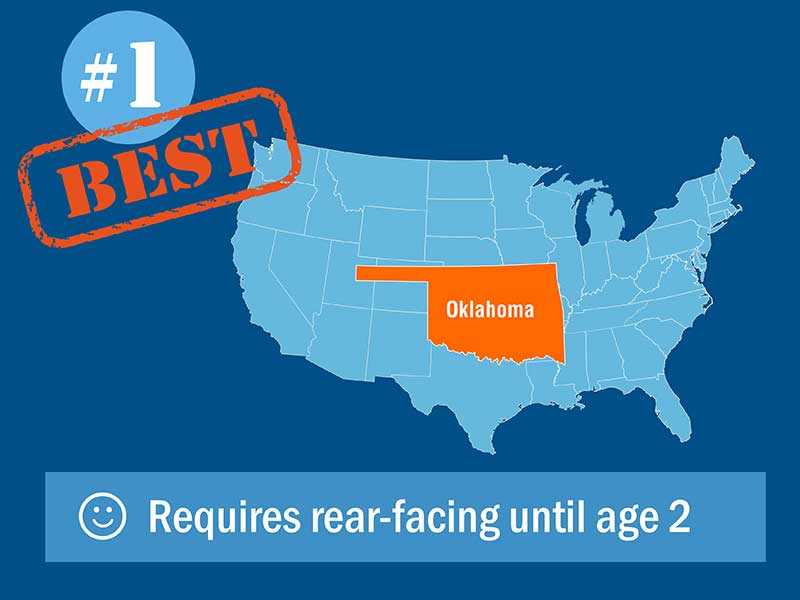Recent Articles
Popular Makes
Body Types
Top 10 Best and Worst Car Seat Laws in America

CHP officer with mom checking car seat
Well, hopefully we all know the answer to this one. The law is…the law. If you don’t follow it, you can get in trouble. Laws are made for various reasons, but automotive safety laws and regulations were created to enforce minimal, proven safety measures. Child passenger safety laws are intended in part to make sure that a child isn’t injured due to an adult’s poor choices.
Yes, you read that correctly. Car seat laws do not matter. Now, before you go out and tell the police that I said it was okay to go ahead and break the law, read on...
With very few exceptions, child passenger safety laws in the United States (and in most of the world, actually) are several decades out of date. Laws do NOT tell you what is safe. They tell you what some state legislators—possibly 20 or more years ago—were able to agree should be the minimum standard for not getting a ticket.
So, yeah, you actually do need to follow the law. But being legal doesn’t make it safe or a good idea. It’s completely legal for me to jump out my second-floor window onto concrete, but I don’t plan on doing that. I could also legally let my three-year-old play with matches and sharp knives, or feed my newborn Reese’s Pieces, but I don’t do that either, because I know that those things could very easily result in severe harm to my kids.
What should you do instead? Follow current best practice recommendations. These are based in years of research by experts in the field. If you follow them, you’ll be doing everything you can to protect your child in the car. Since car crashes are the leading cause of death for children in the United States, you owe it to your kids to make this your top priority.
5th Worst Car Seat Law: Missouri, Connecticut, and New York
The states on the following pages have some catching up to do. When I say “worst,” I generally mean “most permissive.” Parents in the states on the coming pages, IF they only restrain their children to the bare minimums required by law, would possibly be putting them at risk of preventable, severe injury or death in a crash.
So, to begin our worst states, we have:
These three states are the only ones with no requirements for proper use of car seats. "Proper use" means that the restraint must be used according to the instructions, and not to do so is illegal. In Missouri, Connecticut, and New York State, a child restraint can legally be used against the manufacturer instructions. This means that for example, someone who makes the dangerous choice to put a 40-pound child in a seat with a 30-pound maximum weight, can actually legally do so.
New York had a bill proposed in early 2015 that would change the law to require proper use. As of summer 2015, this law has not been passed and its future status is unclear.
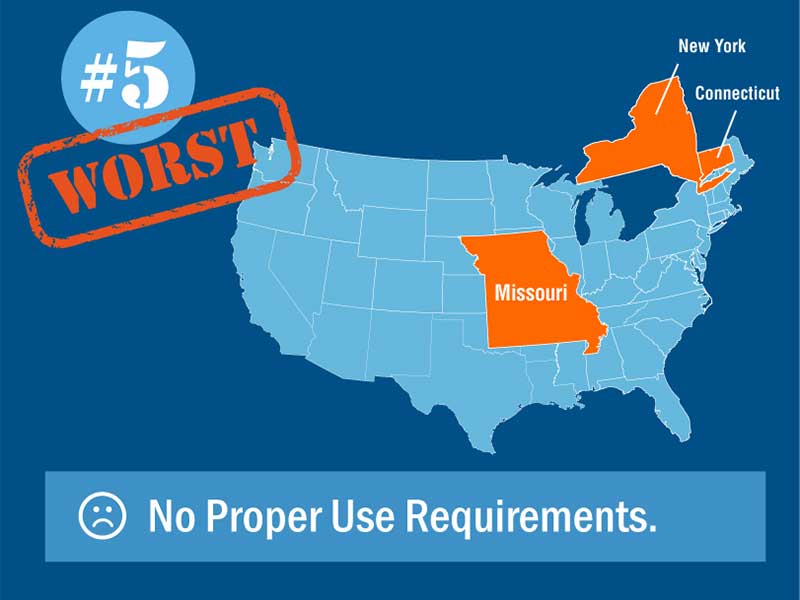
4th Worst Car Seat Law: Montana, Nevada, and Arkansas
Montana, Nevada, and Arkansas only require proper use to age 6 OR 60 pounds, whichever comes first. The majority of states require at least a booster seat until age 8. With such low minimums and the exception for children who reach 60 pounds before age 6, a young child who is very above average in weight (but may still have a foot or two to grow, and several more years of bone development to go through, before the seat belt would fit safely), could legally ride in just the adult seat belt. This is potentially deadly. Here’s some more info on why.
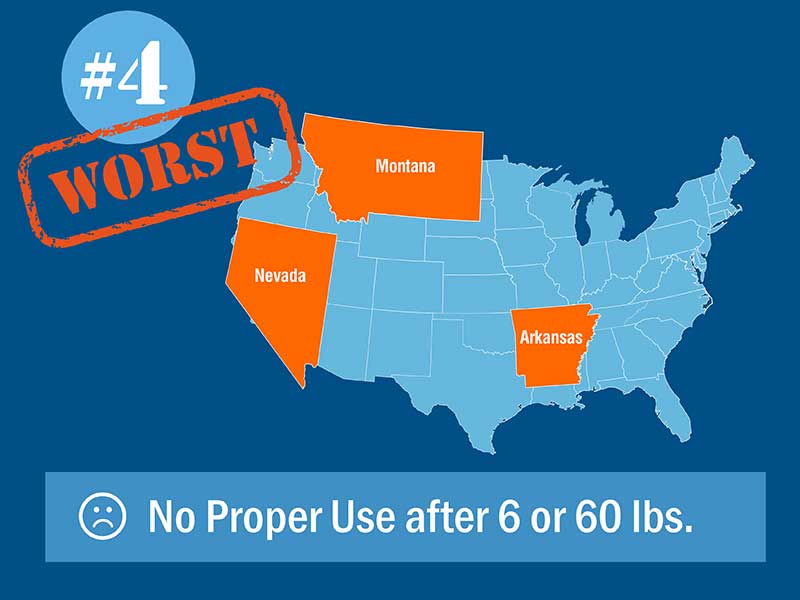
3rd Worst Car Seat Law: Kentucky
Kentucky just passed a new child passenger safety law, which went into effect in June of 2015. Unfortunately, this law was very poorly worded. As a result, it is TECHNICALLY illegal to use a car seat with five-point harness once the child is 40 inches tall. That’s the height of the average four-year-old, and most children need a harness to ride safely until age 5 or 6. Furthermore, some booster seats have a height minimum of 43” or higher, so a 40” child couldn’t even properly use them anyway.
The good news is that, from what I can tell, this part of the law isn’t enforced. It also isn’t mentioned in Kentucky’s handout distributed to parents, and it’s actually pretty hard to track down the full text of the law and understand what it means. It does raise the minimums to go without a booster to 8 years old or 57” tall, whichever comes first, and that’s a positive step. Nonetheless, this is a law that should have been given considerably more thought as far as the wording. Hopefully, it will be corrected in the near future.
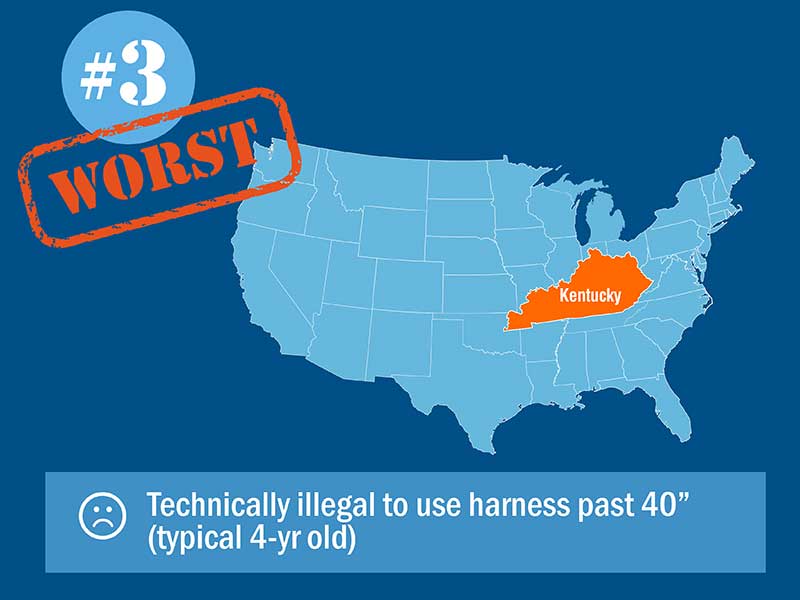
2nd Worst Car Seat Law: South Dakota
The South Dakota law could really tie for the number one worst. In South Dakota, no car seat or booster AT ALL is legally required once they hit 40 pounds or age 5, whichever comes first. This law was last updated in 2001, and didn’t reflect best practice at that time, either. A 40-pound, five-year-old child can legally ride with just an adult seat belt in South Dakota. Considering that the law in some states requires an average age of 11 to stop using a booster seat (this is also the NHTSA recommendation), allowing a child of less than half the approximate safe age and weight to go without a booster is extremely irresponsible and dangerous. Frankly, this law is a disgrace, and South Dakota residents should be sure to contact their representatives about the necessity of major updates.
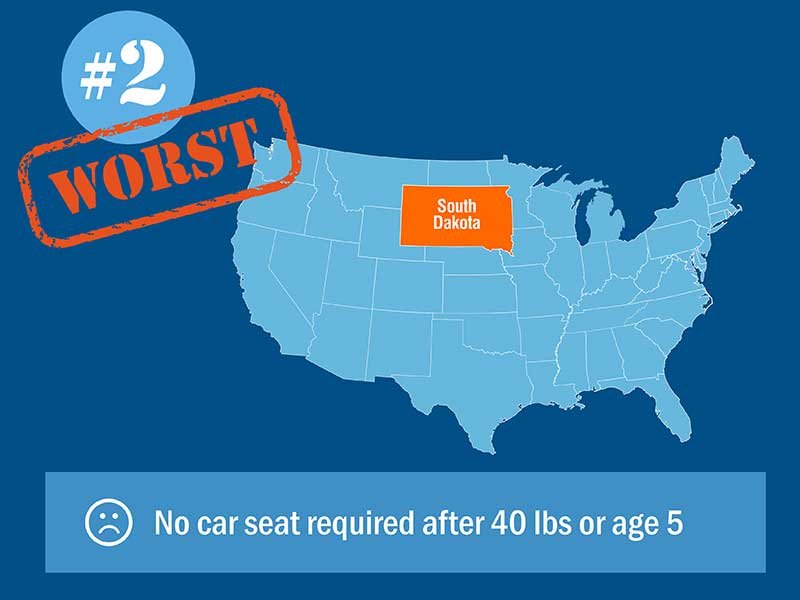
"Winner" for Worst Car Seat Law in America: South Carolina
South Carolina earns the dubious distinction of having the worst car seat law in America. The wording of the law actually requires parents to go against widely recognized child passenger safety recommendations. Technically, in South Carolina it is illegal for a child to rear-face past one year old, or to use a harness past 40 pounds. Best practice is to rear-face until the bare minimum of age 2 and for as long as possible thereafter. It is also proven safest for children to use a five-point harness until they are mature enough for a booster, which is usually not until age 5 or 6. 40 pounds is the average four-year-old. The state also doesn’t mandate proper use of a restraint past age 1.
Unfortunately, unlike a few other states with such poorly-worded laws, South Carolina law enforcement actually has been known to give tickets to parents who are following the AAP and NHTSA recommendations (and possibly their car seat’s instructions) to rear-face well past age 1. Parents can generally get these tickets thrown out by contesting them in court, but it’s wrong that any parent should have to take the time to do that when they’re just trying to keep their children safe. South Carolina residents are encouraged to write their state representatives in support of changing this very unsafe law.
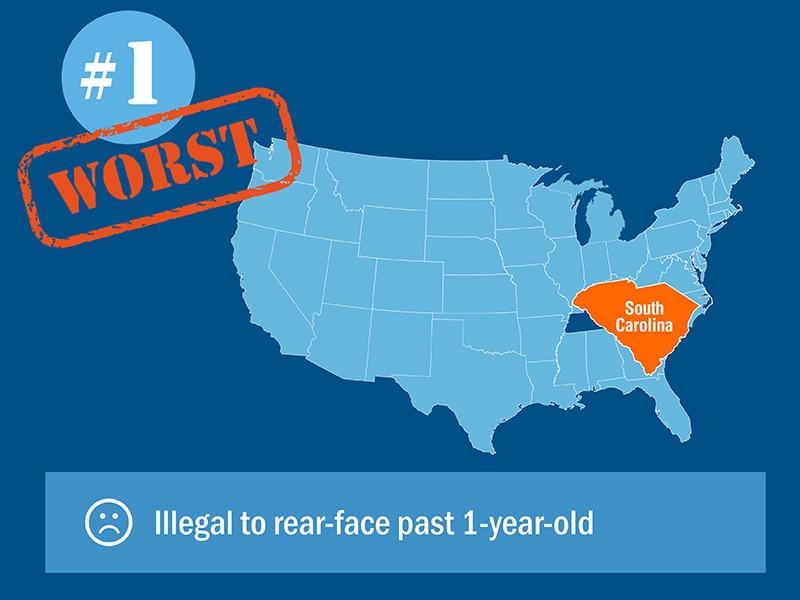
5th Best Car Seat Law: New Mexico
The five states on the following pages have laws that come closest to current best practice recommendations. While no state actually requires residents to follow true best practices, it is refreshing to see that some are making progress in that direction!
New Mexico’s law starts out pretty ordinary. Children age 6 an under, who weigh less than 60 pounds, must ride in a child safety seat or booster seat. However, it then goes on to say that children through age twelve (so, until they turn 13) for whom the adult seat belt does not fit correctly, must continue to use a booster. For most children, the seat belt doesn’t fit correctly until age 10-12, so this law truly does require that they pass the 5-step test to discontinue use of the booster.
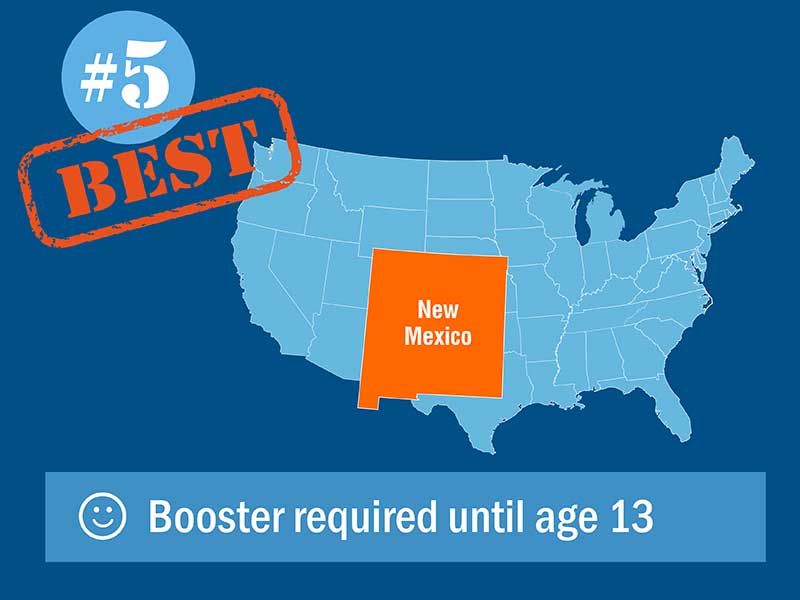
4th Best Car Seat Law: California
California requires a booster until age 8. Many states have that as part of their laws. The California one goes above and beyond by stating that children must continue using a booster until they are 57” tall and pass the 5-step test. On average, this is around age 11, and it would be considered one of the few laws that more or less mandates best practice with regard to booster readiness.
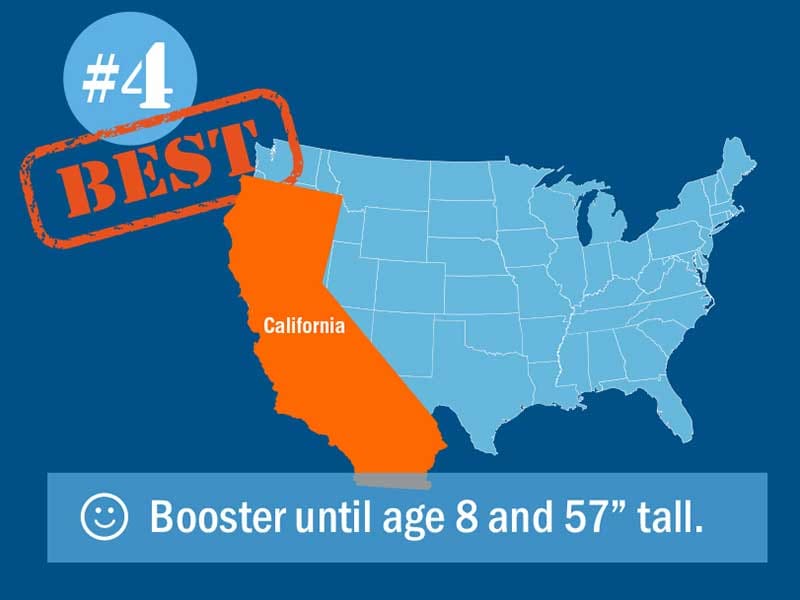
3rd Best Car Seat Law: Wyoming
In Wyoming, the minimum age at which to discontinue use of a booster is 9 years old. This is higher than any other state besides Tennessee, which also mandates age 9 for the adult seat belt. Wyoming goes a step further by stating that in addition to reaching the age of 9, children must pass the 5-step test to go without a booster
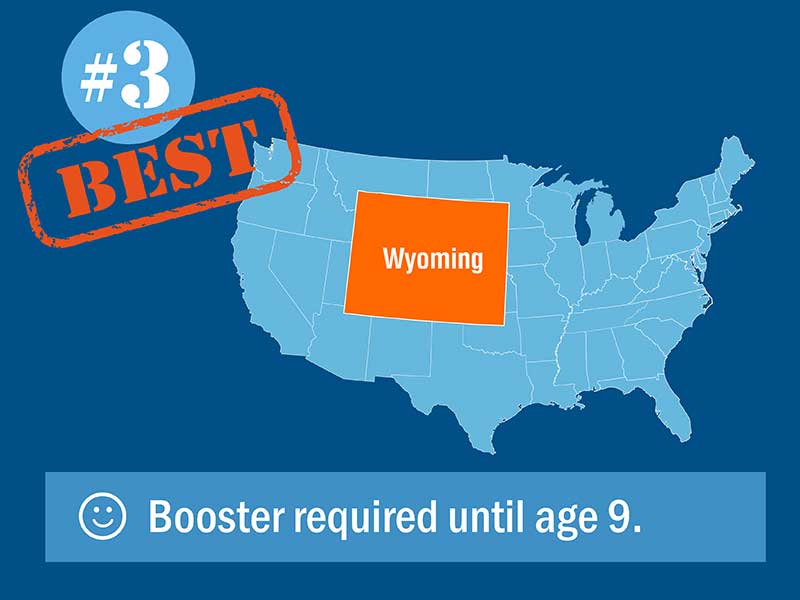
2nd Best Car Seat Law: New Jersey
New Jersey made history in 2015 by becoming the first place in the world to require rear-facing until at least age two. As of September 1, 2015, children must ride rear-facing until age 2 or until they reach 30 pounds. They must also use a five-point harness until age 4 or 40 pounds, and a booster until age 8 or until they hit 57”.
The “or” in these requirements means that this law doesn’t quite amount to best practice. Nonetheless, it’s much closer than almost any other state has come, and will hopefully start a trend towards safer laws for other states as well.
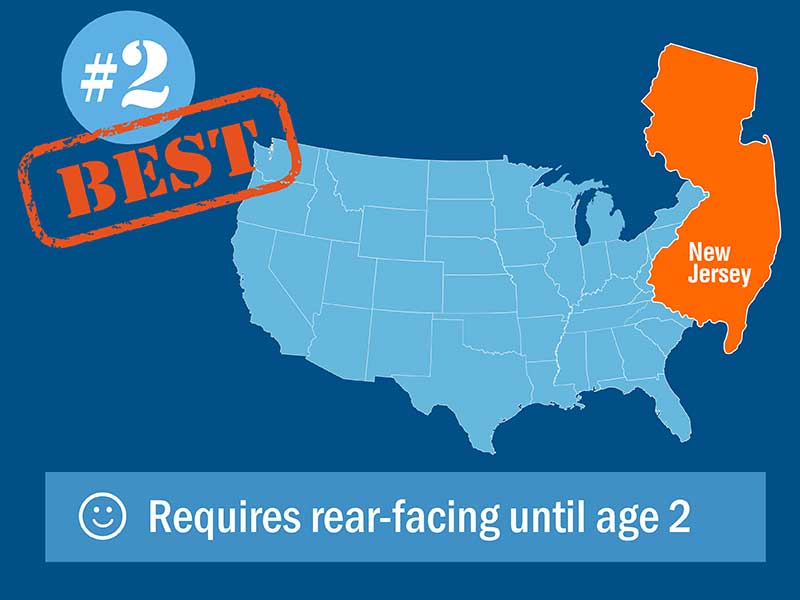
Winner for Best Car Seat Law in America: Oklahoma
We have finally arrived at our winner! America’s best car seat law was passed by Oklahoma in 2015. Starting on November 1, 2015, kids in Oklahoma will have to ride rear-facing until age 2 or until their rear-facing seat is outgrown, whichever comes first. Since nearly all convertible car seats now rear-face until at least 40 pounds, the vast majority of children will be required to rear-face until age 2 at the very least. This law will also requires a five-point harness until at least age 4, and a booster until age 8 or 57”, again whichever comes first. When you compare this law to NHTSA’s current best practice recommendations, it isn’t identical, but it comes pretty darn close. Well done, Oklahoma!
